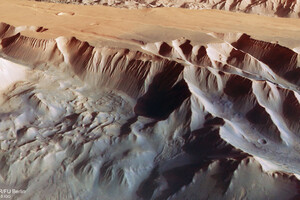Volcanism probably still plays an important role in the formation of the Red Planet.

Until recently, Mars was considered by scientists as a geologically dead planet. But now an international group of researchers has found that volcanism may still play an important role in the evolution of this celestial body, reports Scitech daily.
Since the InSight station landed on Mars in 2018, and on The SEIS seismograph was deployed on the surface of the planet, seismologists and geophysicists listened to the seismic impulses of more than 1,300 Martian earthquakes. A detailed analysis of the location and spectral nature of these events brought a surprise to scientists. The epicenter of the aftershocks was located in the area of Cerberus pits – an area consisting of a series of faults. And this discovery tells a new story that suggests a crucial role for volcanism in shaping the surface of Mars.
Read also: Ancient microbes caused climate changes on Mars that could not survive
A group of scientists led by researchers from the Swiss Technical University of Zurich studied 20 aftershocks that occurred in the area of Cerberus pits. They concluded that they can be explained by the presence of a warm source, probably molten lava at depth. And this indicates volcanic activity on Mars.
The researchers also found that the epicenter of most aftershocks is located in the inner part of Cerberus pits. When they examined orbital images of the area, they found that the epicenter was located near a formation that was recently described as a “young volcanic fissure.” Darker dust deposits around this formation are located not only in the direction of wind movement, but also in all directions. This indicates that volcanic activity could have occurred here during the last 50,000 years. From a geological point of view, it was recent.
Scientists believe that 3.6 billion years ago, Mars was a living planet. At least from a geological point of view. Rocks have been erupting here long enough to give rise to Tharsis Montes, the largest geological formation in our solar system, as well as Mount Olympus, a volcano taller than Mount Everest.
Cerberus craters were named after a mythical dog that, as is believed to have guarded the underworld. Evidence of Martian earthquakes found near this formation indicates that Mars is not completely dead. Volcanic rocks descend and form parallel cracks that push the crust of the Red Planet apart.
Scientists believe that the phenomena currently observed are the remnants of a once active volcanic region. It is also possible that the magma is now moving east to the next eruption site.
Related video
Previously Pennsylvania State University scientists found signs that 3.5 billion years ago there was a large ocean on Mars, which covered hundreds of thousands of square kilometers. Its existence was indicated by the topography of the coastline revealed in numerous pictures of the Red Planet.




